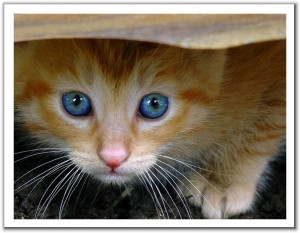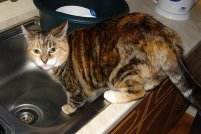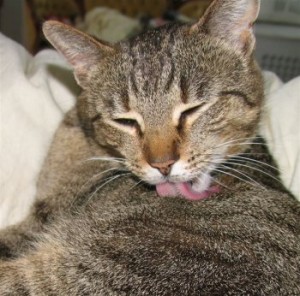Should I Choose a Dog or a Cat as a Pet?
June 13, 2010 by LaBecs
Filed under Should I choose a dog or a cat as a pet?
You want to adopt a pet, but how do you decide if you want a dog or a cat? Well, the obvious answer lies within you: are you a “dog person”, or a “cat person”? Most people already know this, but if you really never thought about it, let’s see what advantages or disadvantages each species has to help you decide.
Cats and dogs have different needs and characteristics. One thing that applies to both is that they all need attention, you need to budget for their veterinary care, food and emergencies, you need to clean after them, and you have to love them unconditionally.
Now, for the differences.
Dogs:
Your lifestyle will definitely determine if you should have a dog or a cat as a pet. If you like to travel a lot, or work all day, a dog is not for you.
-Different breeds have different characteristics, you should choose one that matches your personality and lifestyle.
-If you travel, boarding a dog is quite expensive.
-A dog needs company and attention. If you have a dog and leave him home alone all day, you will have a very unhappy pet.
-Dogs need exercise. More or less depending on the breed.
-You need to walk them at least a couple of times daily for them to do “their thing”.
-Dogs need to be trained, socialized and housebroken.
-Dogs like to play. They need to be stimulated and love to play with their masters.
-Some dogs shed a lot. You have to be prepared to clean after them constantly.
 -Dogs need to be groomed often. You need to brush their coat, bathe them, and brush their teeth.
-Dogs need to be groomed often. You need to brush their coat, bathe them, and brush their teeth.
-A small dog is a little easier to take care of, but it still needs walks, play and attention. A big dog obviously needs more space.
-A small dog eats very little, but a big dog will eat a lot. You have to be ready for the expense of feeding.
-Dogs love to ride in the car and go hiking, swimming and all kinds of outdoor activities.
-A dog will greet you happily every time you come home, he will want to sleep with you, and in general, share everything with you.
-There are many dog parks where you can take your pet to run and play.
-Dogs are protective of their humans and will be faithful forever.
Cats:
If you work outside your home or travel a lot, and the pet needs to be alone for many ours, a cat might be for you.
-If you travel, boarding a cat is not as expensive, depending on the facility. They could be left at home with a pet sitter visiting once or twice a day.
-All cats have different personalities. Some are affectionate lap cats, and others are more energetic and don’t like to be petted as much. Choose carefully.
-A cat can be left alone to sleep most of the day.
-Cats are independent, but that does not mean you can live them alone all day and not pay any attention to them. They do love company.
 -Cats need to play and be stimulated. They entertain themselves more easily without being destructive.
-Cats need to play and be stimulated. They entertain themselves more easily without being destructive.
-Cats are very easily trained to use their litter box, which requires cleaning at least once a day.
-There’s no need to walk them, though some cats like to walk on a leash.
-Some cats are easily trained to do tricks. Some are very good at fetching.
-Cats eat very little depending on their size, but never as much as a dog.
-Cats don’t need to be bathed, but they do need to get brushed and you need to brush their teeth regularly.
-You can get a cat used to car rides, but they mostly prefer to stay at home.
-Cats can live in small apartments. It’s actually better to always keep them indoors.
-Contrary to popular belief, cats will greet you at the door and follow you around like a dog.
-Cats are playful and a delight to watch as they jump and run and chase.
-You need to have space for a litter box in a well ventilated area, away from kids and out of site.
-Cats like to have scratching posts or kitty condos.
-Cats love to cuddle.
-Cats can be very protective of their humans and will be faithful forever. They do get attached to their owners.
I am one of those strange people that is a cat person and a dog person. I love them both with all my heart and enjoy their different personality traits. I have never had two cats with the same personality, it’s always an adventure to get to know them. And dogs for me, are the best company you can ever ask for. But one thing is certain, both species are incredible, and everybody should have the experience of living with one or both of them at some point.
Learning to Coexist With a Trouble Making Cat
September 7, 2009 by LaBecs
Filed under Learning to Coexist With a Trouble Making Cat
Even the most ardent fan of the feline species has to admit that cats can be little trouble makers.
While dogs can cause quite a bit of mischief themselves, your cat’s intelligence, size, and nimbleness can help him or her cause more than a little bit of aggravation for you from time to time. But don’t worry. The two of you can learn to live a harmonious life. Here are some strategies that can help you when you have cat trouble.
Strategy #1: Learn Feline Nonverbal Communication
You’d be surprised how much easier your life would be if you simply understood the nonverbal communication messages your cat is sending your way. For example, if your cat has a habit of nipping you as you pet him, start watching for a few key signs, such as pinned back ears and a flicking tail. These are all signs that affection time is over. If you don’t take the subtle hints, your cat has to give you something you will notice: a nip with her tip. By stopping when you see these signs, you can end this problem for good.
Strategy #2: Appreciate the Value of Scratching
 While scratched up furniture might not be much of a value, your cat’s claws are valuable to her. She uses them to give her a sense of safety and to help her manipulate her environment. Sometimes your couch just gets in the way. The best way to stop these types of unwanted behaviors is to invest in a scratching post and rub some cat nip on it. This will encourage your cat to use the post and to leave your furniture alone. There are also special adhesive strips to avoid this problem. NEVER think of declawing. This surgery is cruel and unnecessary.
While scratched up furniture might not be much of a value, your cat’s claws are valuable to her. She uses them to give her a sense of safety and to help her manipulate her environment. Sometimes your couch just gets in the way. The best way to stop these types of unwanted behaviors is to invest in a scratching post and rub some cat nip on it. This will encourage your cat to use the post and to leave your furniture alone. There are also special adhesive strips to avoid this problem. NEVER think of declawing. This surgery is cruel and unnecessary.
Strategy #3: Learn Their Language
Cats are like human babies. An infant cries to get what it wants, but because the baby can’t articulate what it wants in a vocabulary we understand, fulfilling the child’s needs can sometimes be frustrating. That’s the way it is with cats and their meowing. Incessant meowing can, admittedly, be annoying, but it is not being done to make you go crazy or to make ear plug manufacturers wealthy. Your cat is trying to say, “I want this. Please give it to me.” As the human, you have to learn what “it” is. Sometimes it’s food, a change of litter, or affection. A non-spayed female will meow a great deal when she is ready to mate. Trial and error is the best approach. Just remain calm and remember the meowing is a cry for assistance and not a tool for torture.
Strategy #4: End Bad Digging
Cats enjoy digging – something you may have noticed. They use digging to cover up their waste in the litter box, but they will also go digging as a way to entertain themselves. Your cat might, for example, decide to dig up your garden or your houseplants. Be proactive. Go to the grocery store and buy some fresh citrus fruits. It doesn’t matter what kind you get. Cats aren’t font of anything citrus. Remove the rinds from the fruits and bury them in the soil where you do not want your cat to dig. This will work wonders. But it might be a good idea to give her a safe outlet for her digging passion, such as a small sandbox in your fenced in backyard or a pot of dirt of her very own.
in the litter box, but they will also go digging as a way to entertain themselves. Your cat might, for example, decide to dig up your garden or your houseplants. Be proactive. Go to the grocery store and buy some fresh citrus fruits. It doesn’t matter what kind you get. Cats aren’t font of anything citrus. Remove the rinds from the fruits and bury them in the soil where you do not want your cat to dig. This will work wonders. But it might be a good idea to give her a safe outlet for her digging passion, such as a small sandbox in your fenced in backyard or a pot of dirt of her very own.
Following some of these strategies can make living with your cat much more enjoyable for both of you.
Why Does a Cat Stop Using the Litter Box?
June 29, 2009 by LaBecs
Filed under Why Does a Cat Stop Using the Litter Box?
While cleaning out the litter box is not a wonderful chore that anyone enjoys, it is a necessity for your cat. This is, after all, your cat’s bathroom area and cats have a tendency to be very fastidious. If your cat suddenly starts having litter box problems and using the bathroom elsewhere, this might be a sign that you need to be cleaning that box more often. However, it can also be a sign of other problems, including serious medical conditions.
Reason #1: Busy Location
Cats are private animals. While a dog will do its business outside with everyone in the world watching and think nothing of it, cats have to relax in order to get the job done. If the litter box is located in an area where people are always coming and going, that’s going to be upsetting to your cat and he or she is likely to go elsewhere in the house, usually some place quiet like a corner.
Now, if you haven’t moved the litter box and if the traffic in the area hasn’t increased lately, but your cat has suddenly stopped using it, there’s probably another good reason.
Reason #2: Cat Preferences
Cats seem to be a lot pickier than dogs about everything from toys to food to sleeping locations. They are also sometimes very picky about their litter boxes. Many cats like certain types of litter better than others, possibly because of the way it feels on their paws. Other cats have litter box type preferences. While some love to have the covered boxes for more privacy, others prefer something that is a little more open so they can what is going on around them.
As with the first reason, if you haven’t made any changes that might upset your cat’s preference but he or she has suddenly stopped using the litter box, there is probably a different reason as the root cause.
Reason #3: Medical Problems
In some cases, a urinary infection or some other health problem can cause cats to have litter box problems. They may have a hard time going to the bathroom or may associate the litter box itself with discomfort which makes the box undesirable. If the sanitary reasons and the first two reasons don’t seem to explain the sudden change in your cat’s behavior, you should seek advice from a veterinarian immediately. Your cat might have a very serious health problem.
If you cat is defecating outside the litter box, he or she may have worms, gas, or other intestinal distress so a vet visit is definitely recommended. Remember that once your cat starts using the bathroom outside of the litter box, cleaning it with a solution that will destroy the enzymes in the urine or feces is essential. Otherwise your cat is going to continue to view that spot as an appropriate choice for going to the bathroom.

Amanda
Reason #4: Behavioral Problems
If you’ve ruled out all of the other reasons, you’ll have to start thinking like your cat and trying to pinpoint what may be the real problem. Anxiety can be one reason. A cat that doesn’t like to be left alone may use the bathroom outside the litter box as a sign of separation anxiety. A cat that’s angry because a new family member or pet has come into the picture may also start protesting by not using the litter box correctly.
When emotional issues are involved, you may find it harder to pinpoint the cause. However, you may be able to work with your vet on figuring out the best way to solve the problem so your cat can start using the litter box again and you can cut down on cleaning the carpet and other areas of your home.
Unfortunately, it’s very hard to fix a behavioral problem if you don’t know the exact cause. However, with patience and love, you might be able to find the cause and fix the problem. Sometimes medication can help. Do your research before taking any drastic measures. Always remember that no matter what he or she does, it’s not done to spite you. Cats are not capable of those ‘humanoid’ feelings. If your cat is having litter box problems, he doesn’t deserve to be punished or God forbid, euthanized, just because we don’t understand his reasons.
Excessive Grooming in Cats
June 6, 2009 by LaBecs
Filed under Excessive Grooming in Cats
In many cases, our pets develop issues that need special attention and there may be signs of potential problems. One of these issues is apparent when you observe excessive grooming in cats.

Beluga
Cats must groom themselves. It’s a natural part of their behavior. However, under some conditions, cats can groom themselves excessively. While you may not think this is a serious issue, it can be. If you notice excessive grooming in your cat, pay attention. They will vomit hairballs more often. In any case, try not to let it go on too long. The cat can end up with bald or red spots in certain areas of her skin, or an open sore.
Excessive grooming in cats can be linked to a lack of attention, boredom, insufficient grooming by the owner, and even separation anxiety. Many of us have a misconception that cats don’t need attention because they are aloof, independent, and free-spirited. That’s not the case. They may not be as needy as dogs but that doesn’t mean they don’t need attention and affection regularly.
If you notice your cat grooming too much, try distracting him or her, play a little bit. If the behavior then stops, you can attribute it to boredom and then you might help by providing more distractions. However, if the cat goes back to grooming right away take him or her to the vet as soon as possible. The vet can rule out parasites or a fungal infection. Your cat may be having an allergic reaction or could be suffering from an autoimmune problem. He or she can help treat the medical problems and can also assist you in stopping the behavior to prevent future medical issues. The vet might prescribe antihistamines, herbal calming remedies, and antianxiety medications that can help break the cycle and calm your cat.
While knowing what caused the behavior is not always necessary for effective treatment, it may help you to understand what brought about your cat’s obsession with excessive grooming. Changes in the environment and the resulting stress can sometimes be a cause. For example, if you have just added a new member to the family – feline, canine, or even human.
You won’t be able to tell from the behavior itself whether the cause is psychological or physical, but excessive grooming should definitely be discussed with your vet, especially if it accompanies other changes in your cat’s behavior, such as reduced energy levels.
The bottom line is that you should talk to your vet if your cat’s behavior disturbs you in anyway. Observe your cat and groom him or her yourself regularly. Being aware of any changes in your cats behavior can avoid difficult medical problems down the line.
Top Ten Friendliest Cats
April 24, 2009 by LaBecs
Filed under Friendliest Cats
I think all cat owners have made this mistake: they go to the shelter or rescue and choose the cutest cat in the bunch, without even considering its temperament or personality. Then it turns out the cat ends up not being what they expected. Some are timid, some like to be petted and others don’t, others love to play, while others will hide under the bed all day. What are the friendliest cats? When you go to the shelter or rescue, always ask the people in charge what breeds the cats they have there resemble the most. They will almost always tell you, “This one has a little Ragdoll in it, this other has a bit of Maine Coon”, and many times you will find pure breeds that have been abandoned… so keep this list of the top ten friendliest cat breeds before you go to find the most wonderful treasure you will ever have.
Click on each picture to see their wonderful qualities:
(See below for a list of picture credits)
 #10 Chantilly-Tiffany |
 #9 Somali |
 #8 Ragdoll |
 #7 Persian |
 #6 Manx |
 #5 Maine Coon |

#4
Burmese |
 #3 Birman |
 #2 Exotic Short Hair |
 #1 Abyssinian |
CLICK HERE TO SEE THE FRIENDLIEST DOGS…
Photo Credits:
Persian Cat

